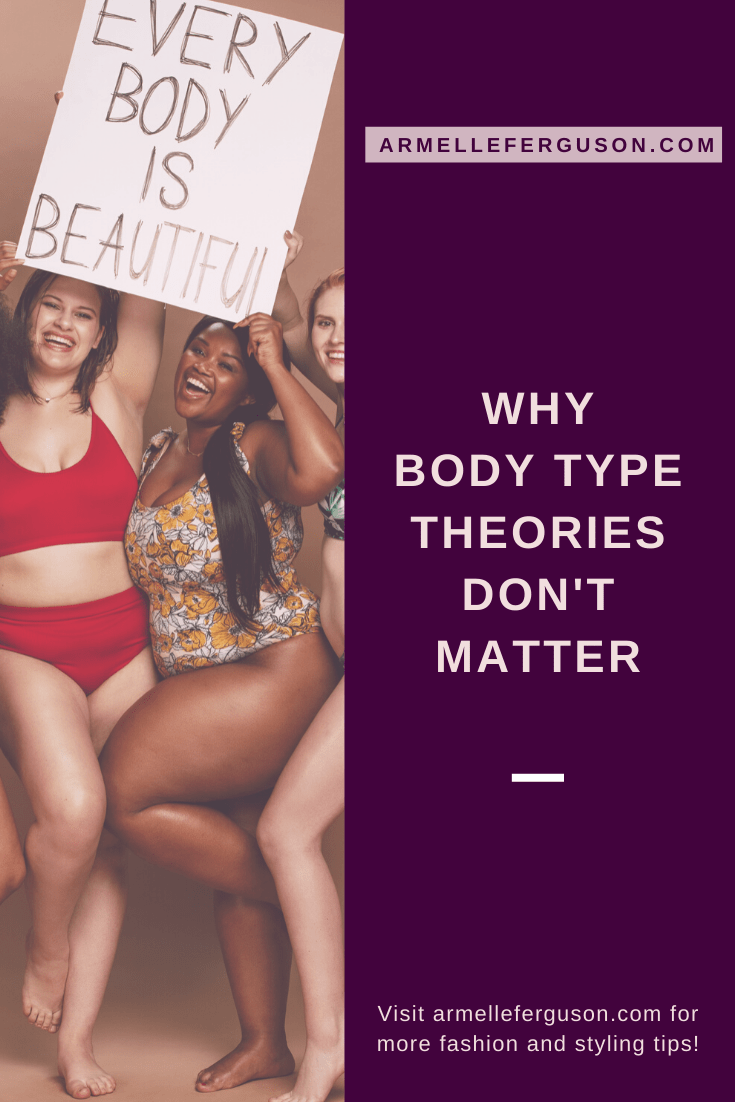
Body Type Theories: Why I Don’t Care and You Shouldn’t Either
If you’ve been around here for long enough, then you know how I feel about rules: to summarise, I’m not too keen on them. I simply don’t like the idea of forcing people to fit into a box. Don’t get me wrong, I totally get it; it can make things easier and fun – of course, I look at my sign when I stumble upon anything related to astrological sign, even though I don’t believe in it! But when it comes to certain things, I actively stay away from any category-related stuff. And that applies to style. So no, no body type theories for my clients and me; and no colour theories for my clients and me.
The main reason behind that is simple. I don’t believe in body type theories, because they force upon us, ideas and standards that most of the time, are simply unrealistic. And it can affect the way we interact with our body, and even trigger unhealthy behaviours.
A question I get asked quite regularly is “How should I dress my body type?”, or sometimes I hear a slight variation of this “I don’t know my body type? Can you help me identify it, so I know how to dress my body?”. And honestly, this usually makes me a bit mad. Not at the person asking, of course not! But just mad at the whole concept. Mad that we feel the need to know which box we fit in to be able to think that we are dressed as our best self.
I always try to remind anybody asking me these questions that their style is entirely dependent on their taste; the way they feel in their pieces; the type of aesthetic they want to embody, and the message they want to convey. Fashion, even though it is a massive industry, is also an art! And there should be no rules to art, that’s how I feel. You should all be free to wear what makes us feel good and look good.
So what are body type theories? And should you dress for your body type?
You’ve probably heard about body types in casual conversations or even stumbled upon a few terms in women’s magazine. Interestingly, I’ve never heard about male body types, but I’m not an expert there, so I might simply not have come across it yet. Body type theories categorise women’s body, based on proportions and measurements, and count anywhere between six and twelve standard types. Depending on the shape of your silhouette and your measurements, you’ll fall under a category.
So why is it a problem then? I mean, should we not be able to find guidance to know how to dress our body based on our measurements? And to this, I say yes! Of course, your clothes should fit you and your measurements, but that’s not exactly what body type theories are for.
Body type theories idealise a specific type of body, and push the idea that other bodies should try and visually imitate that “perfect body”.
The recognised “perfect body” right now is the “hourglass” body. It’s basically when your shoulders and hips are of pretty similar width, and your waist is marked. This is supposedly the perfect body type, and if your body naturally falls under the category, then you’re lucky!
If your body type is anything else than that, however, then you have to “fix it”, and visually give the illusion of an hourglass shape. And I hope we can all identify the problem with that kind of rhetoric.
I mean, first of all, less than 10% of women present a natural hourglass body shape. So that would mean 90% of us need to give the illusion of a body we do not have. I’m not sure about you, but I don’t see how this could possibly promote self-love and body acceptance.
Our body is our most loyal companion, from birth. The least we can do is appreciate it the way it is. Wanting to be healthy is one thing, but trying to give the illusion of something that is not is a whole different story. Unfortunately, most personal stylists will adhere to these concepts, and tell you how to “correct” your body type, to give the illusion of an hourglass.
The Perfect Body Type is Always Changing
Another reason that makes this wholly null and void is this: “perfect” body types change all the time! If you look at the most beautiful women in history, from Audrey Hepburn to Marilyn Monroe, to Jackie O, to Kate Moss, to even Beyonce, none of them has the same body type. This is totally a matter of taste and personal preferences, and I’m not even talking about cultural influences and fashion industry.
In the 1920s, the androgynous look was considered perfect, and women were deemed to be beautiful when they had flat breast, little to no waist, and tiny hips.
In the 1940s and 1950s, with the rise of the pin-up aesthetic, breasts got full, waists got small, and hips got wide. The hourglass to pear body type was the most beautiful, according to that era’s standards.
The 1980s emphasised height, and tall, slim and small hourglass type bodies became a symbol of beauty.
We could go deeper into the history of body types and standards of beauty, but I think my point is clear now: body types don’t matter. The only body type that matters is yours, and it also happens to be the perfect body type for you!
I hope I’ve convinced you now to just forget about the original question “How do I dress for my body type?” because the answer is always going to be the same for me. Find your signature style and go from there. It’s about your tastes and your personality; not some arbitrary oppressive rule.
It took me time to let go of these limiting beliefs, and focus on what felt right to me; so I get it: the social pressure is real. But I can tell you this: the freedom mindset is so worth it! I can now truly embrace my style, the one I created for myself. And my mission is to help you do the same.
Have you ever wondered and worried about dressing for your body type? Let me know in the comments below, I would love to hear your experience when it comes to loving your natural body shape.







Add A Comment